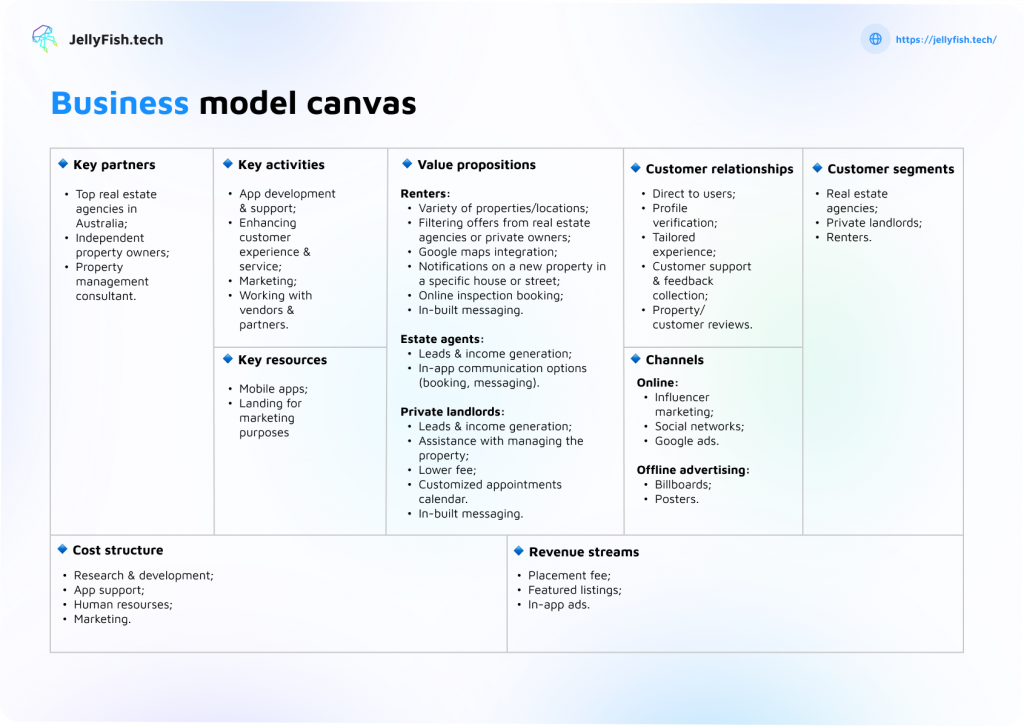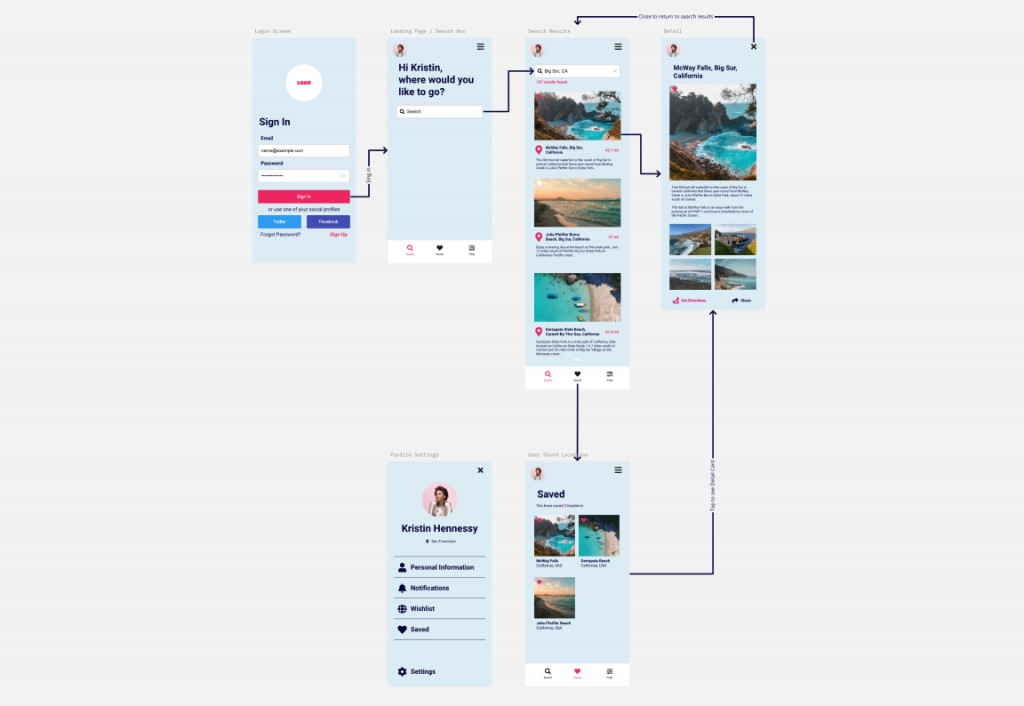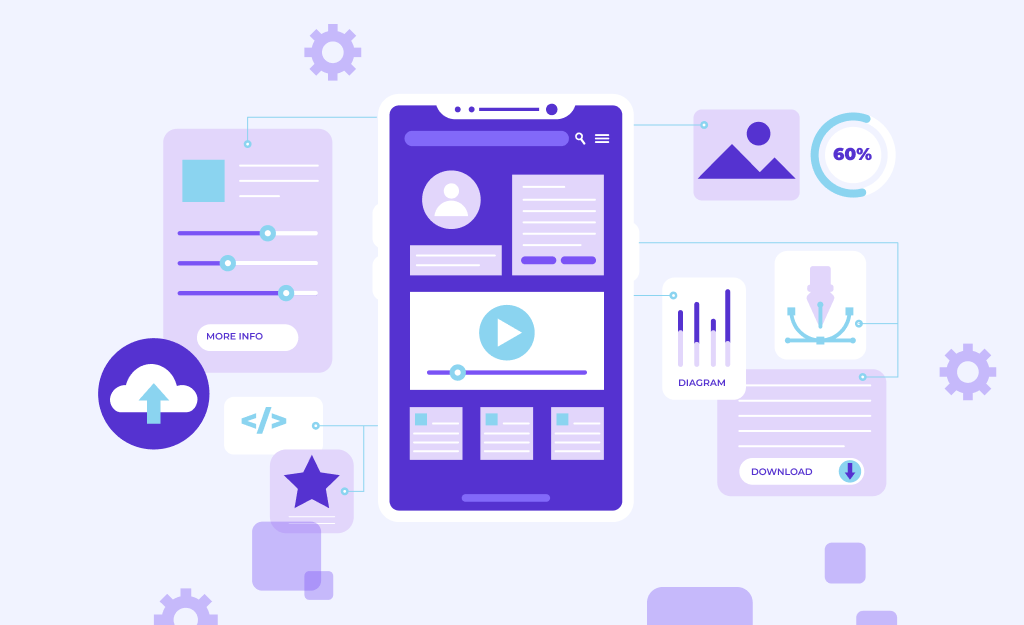Three Pillars of Testing Your Startup Idea
Only 10% of startups succeed each year. Not the best line to start with, isn’t it?
But when a brilliant idea comes to mind, you rarely think about failure. You probably feel like bringing this idea to life ASAP and starting winning the market.
However, by following the impulse, many entrepreneurs often fail to do the groundwork that helps validate or disprove the idea at the early stages, investing minimum resources.
As a result, they lose time, money, motivation, and contribute to the statistics of unsuccessful startups.
Why do we know this?
Since the Jellyfish.tech team has been in the market of web & mobile development since 2016, we’ve seen a lot of success and failure cases (we’ve even made the one with our product, but it’s another story).
Now, we can say for sure that market research and customer development made at the very beginning together with the properly defined product/service positioning could save you from wasting your resources. And the cool thing is you can do it yourself!
So, enough talk, let’s get down to the groundwork.
Contents:
- Doing the groundwork
- Revealing market interest
- MVP to validate your product idea
- Attracting the investments
- Customer success story
1. Doing the groundwork
The lack of product-market fit (the level of match between your product offerings and your target audience needs) is the #1 reason why startups fail.
That’s why your first step is making sure your audience has a problem that you can solve with your product. And this problem is really huge.
Detecting the pain
This is a starting point of a startup idea validation that requires you to be as specific and impartial as you can be. At this stage, you should do some research and write down the answers to the following questions:
1. What pain point(s) are you trying to solve?
2. Who are the people whose problem you’re solving?
3. What are the roots of their pain point(s)?
4. Are there any other solutions on the market? How could yours be different from them? (Will it really be different?)
5. What resources will you need to solve the problem?
As a result, write down a list of hypotheses that need to be either confirmed or disproved during the next steps.

Defining your value proposition
At this stage, you need to differentiate your product from the competitors and craft a unique value proposition for your audience.
The first thing to do is to clearly define which place your idea will take in the market (technically, it’s called product positioning). Let’s check the basic stages of crafting a product positioning strategy, which result in creating a unique value proposition (UVP = Problem + Solution/Product).
- Competitors analysis. Analyze the products your competitors offer, the strengths and weaknesses of their sales pitches/value propositions.
- Target audience analysis. Learn as much as you can about your target customers: segment them (if required), keeping in mind their pain points, explore their routine, motivations, goals, and frustrations using Q&A forums, social media, niche articles;
- Define the value you could bring to your prospects. Craft a value proposition for each customer segment, highlighting the unique features of your product that help your customers solve their problems better than any other solution.
- Think of the ways to get your UVP noticed by your target audience. Here, I’m talking about a kind of a high-level marketing strategy that helps you reach out to your prospects. (I.e. where?: in blog posts, how?: by creating a series of copies, explaining how exactly customers could solve their problem using a specific product feature(s).)
Besides, think of your pricing model & revenue streams, which could also be pretty high-level to be adjusted during the next stages.
To sum up your findings at this stage, I offer you to fill in the business model canvas, a one-page document that captures and visualizes the main points of your business model.

2. Revealing market interest
Through landing page
A landing page is a good way to reach out to your audience with your proposition and check if they appeal to it. The good news is you can create it without any assistance using various landing page builders and stay on budget.
Using a landing page, you can build up a list of early adopters, collecting the customer subscriptions for product testing or early access. For the provided contact details, your audience may receive bonuses or rewards (a checklist/guide helping them deal with their problem or a product discount), which increase their engagement and build brand attachment.
You can also try paid advertising leading the clickers to your landing page to find out how relevant your offer is. However, in this case, I’d recommend hiring a PPC expert, especially if you have no experience with launching Google/Bing ads.

Using pre-ordered process
Pre-order is a purchase of a product that hasn’t yet been released. There are many reasons why pre-orders are used, but in the case of validating the audience’s interest, product demand prediction comes first.
Together with revealing the expected demand for your offer, you could also discover your audience’s preferences, understand which questions they will ask, edit the list of must-have and nice-to-have features, and get the initial feedback.
Through user research
User research helps discover & collect information about the needs and pain points of the target audience.
In this way, you can reduce or avoid inaccuracies and directly connect with your customers to learn what they think about your idea.
The good news is you’ve already done the part of the user research process while defining your value proposition. So, the main task here is to streamline all your data and prepare for customer development interviews, during which you ask your questions face-to-face, checking how accurate your assumptions are.
Regardless of the form of the interview, you’d focus on the following points.
- Clearly define your goals. What results should you get after the interview?
- Find the people for the interview. Being where your customers are is an essential part of success. Attend the industry events, join the shared interests groups, read the media your customers read, network. And don’t be afraid to reach out to your prospects with your idea, asking for their opinion.
- List the specific questions, which will help you reach your goal. For example, “What tasks take up the most time in your day?”, “How motivated are you to solve/improve [problem/process]?”, “Have you tried the tools/applications that solve the problem? What do you like or dislike about them?”, “If you had a solution to this problem, what would it mean to you/how would it affect you?”.
- Don’t just ask questions, observe! Lucky you are if there is a chance to observe your prospects working. Watching their routine could give you a deeper understanding of the problems they face and the most efficient ways to solve them with your tech.

However, you should always remember that even the smoothest interview doesn’t give you a 100% guarantee your prospects will become the paying customers. It’s still a good option to get in contact with your audience and learn some valuable insights to adjust your product vision, but without MVP your picture would be incomplete.
Building a prototype
At the prototyping stage, you create a product demo/design simulation allowing you to:
- Show the prototype to prospects, conducting usability testing.
- Gather the feedback required to validate/disprove your idea.
- Communicate your product concept to a tech team accurately to build an MVP.
Although a prototype is only an interactive visualization of your product based on the data you got during the previous stages of research, it helps you get tangible results when checking if the product concept works.
You can either ask your designer to make a prototype for you or do it yourself using a bunch of tools:
- Miro (a friendly tool for click-through prototypes generation)
- InVision (easy and reliable, allows you to turn images, text, shapes into a prototype, add comments, and upload it to the cloud).
- Webflow (great UI builder for creating a prototype with no coding skills).
- Proto (an intuitive web & mobile prototyping tool with a drag and drop interface).
You can also pitch your prototype to investors and stakeholders, which significantly increases your chances to get funded.

3. MVP to validate your product idea
After going through one or several above-mentioned steps and getting positive feedback from your prospects, you could start to build the first version of the product (MVP). It’s good if you have a reliable tech partner who really gets your idea and helps you implement it in the most efficient way.
The only advice is to gather and streamline all your findings to clearly communicate your requirements and document everything to get the MVP built exactly in the way you want it. You can use a set of MVP templates our team prepared for you to keep all the important data handy.
Stay open to discussion and listen to your tech team, as they may offer a bit different technologies/ways of implementation that could really save your budget and enhance the product.
Why not release the full-featured product instead of MVP?
Once upon a time, a customer came to us with an idea. He wanted to create a content collaboration platform with an article database (similar to Scopus) for a scientific community. The initial product development estimate was $70k. Too much to lose in case the idea doesn’t work out. Our team offered to slow down and have the discovery phase first to understand if his audience really needs all this functionality. As a result, we proved it’s better to focus on one killer feature — content collaboration and release an MVP that cost $30k. We also turned an idea into a concept, made a feature list, the roadmap, and prepared all the documentation for the development stage. If the idea was validated by real users, we would add the features, including the article database.
So, I strongly recommend you to start small: focus on one-two killer feature(s) that address customers’ pain points and see where it goes before investing significant budgets into development.
The advantages of building an MVP first:
- You won’t invest an arm and a leg. The MVP contains only core features that allow you to approve/disprove the idea, investing the minimum resources.
- You’ll validate the idea quicker. Using MVP as the main tool to validate a business idea, you can get tangible feedback from your target audience in 6-10 weeks together with the first paying customers.
- You’ll get feedback before scaling. Even with all the research you’ve done, there’s still a chance of not catering to all the needs of your customers. So, there should always be room for adjusting product-market fit/pivoting/adding features/enhancing the UX before investing in product scaling.
Keep in mind that the main purpose of an MVP is to find out how good the idea is in practice. So instead of focusing on releasing a perfect product, make sure it has the core functionality included.
After releasing a minimum viable product, your main task as a founder is to gather a target group and make them use your product to get feedback. Based on this, you’ll define the further steps (i.e. reaching out to investors, adding or enhancing a feature, A/B testing, pivoting, etc.).
Attracting the investments
At any of the above-mentioned stages of startup development, you may seek investments to launch the first/further version of your product.
Investment is the lifeblood of startups. This is especially true for the early stages of startups and small businesses. In fact, there are many investment options, so you can choose what’s relevant for you.
| Option | Description |
| Bootstrapping | In this case, founders use their own resources to fund a startup. As a rule, this type of investment is used when founders don’t want to share a company’s stakes with third parties and have enough resources to build an MVP. |
| Loans | In this case, the startup founders borrow funds in banks or take business/personal loans. |
| Government grants | Dozens of government grants are usually available in many countries to lower the price of launching a startup and help entrepreneurs. Feel invited to google the grants offered in your country, read the application rules, and try your luck! |
| Angels investors | Individuals invest their own money in your idea, getting a share in a company or a sizable return of their investments (usually, twice or thrice as large). The investors often offer mentorship, useful networking, and advice on improving the business as well. |
| Venture capitalists | Individuals/firms who invest money of corporations, investment companies, pension funds in start-ups with high growth potential. Venture capitalists buy shares in a startup company and aim for strong management as well as the uniqueness and competitiveness of a product or service to maximize their return on investment. |
| Accelerators and incubators | Via accelerators, startup founders can seek mentorship and funding for projects within a specific time frame. As for incubators, they assist startups in finalizing their ideas, creating business plans, and increasing the relevance of products and services to the market. |
| Crowdfunding | This is the common way of getting money from a large group of people using social networks or special platforms like Kickstarter, Ulule, GoFundMe, etc. |
I asked the investors and venture capitalists from the Jellyfish.tech network to highlight the crucial factors for them when choosing a startup to invest in.
The main thing for me when assessing a startup idea is proof that there’s someone who needs it, otherwise called traction. The other factor is team, and what about them gives them the unfair advantage to succeed where others will fail.
James Green, Co-Founder at DQ Ventures
Mostly the team, it’s mindset, skills and experiences and precise go-to-market strategy on interesting, growing market.
Robert Grygorowicz, Investment Associate at SpeedUp Venture Capital Group
A good investor deck and financial model are the most basic requirement you need to get a chance in front of an investor, so invest time and resources into them. But to get investors to invest, founders have to recognise that early-stage investment requires a leap of faith in the team that they are the best team to deliver; investors will also need to believe that they can partner and add value to the business.
Ivan Hoo, Co-Founder at Inverse
One important factor is that startups do their homework before approaching investors and preparing their relevant data and documents to be able to answer difficult questions by the investors. Another would be to do their due diligence on the investors and make sure they approach investors who would be the right fit and actually interested in their vertical and geography.
Michail Kosak, Co-Founder at DueDash
The two most important factors when investing in a startup are timing in every aspect and team, specifically founder market fit.
Haley Fradkin
Customer success story
Generating an amazing idea is only the beginning of a fascinating, hard, frustrating, and rewarding startup journey. It’s inspiring how founders are following their dreams, but sometimes they forget about the reality: every idea needs validation.
I hope the long to-do list doesn’t scare you off. The truth is every founder goes through this process, customizing the steps to their concept and niche. To be completely honest with you, it’s quite an impressive amount of work that often can’t be done by anyone except for the founder. However, there’s definitely the light at the end of a tunnel!
I asked our dear customer who made and scaled an MVP with Jellyfish.tech to share his startup journey with you and say: “You’re not alone!”.
“Years ago I had a colleague who was a senior auditor in the company I worked for. We kept in touch after I left for another job. Being interested in what his work I asked him to describe how he audited. Surprisingly to me most of the work was done with paper, spreadsheets, and email. I blurted out, “why don’t we make an app?” and he immediately replied “yes”. I couldn’t turn back now.
We teamed up and looked for developers to help us. We vetted 35 developers, both individuals and companies. JellyFish.tech came out on top, because of their apparent expertise and their genuine care for their clients.
We really did not have anybody to talk to about our MVP. It felt more like we just jumped off the edge of a cliff and learned how to fly on the way down. It was through Jellyfish we learned more about the process.
We had funds to develop an MVP that we could demonstrate to our potential clients. It consisted of an auditing web app, a cloud database server, and an administration dashboard. The development process went over the next few months. Our dedicated JellyFish.tech project manager was empathetic, direct, and showed great interest and care for our project. The result was great UX/UI, both functionally and aesthetically.
We presented our MVP at an industry exhibition receiving much praise. Shortly thereafter the pandemic shut down most of the world and put us in limbo for a long time, like so many others. As society opened up we started prospecting potential clients who showed interest in our services.
We have now signed auditing contracts with multiple clients and we look forward to taking our MVP to the next step by adding more functionality and automation. The future looks bright!”
Finn, CTO
What can I add? Stay strong, don’t be afraid to make mistakes, seek support, and delegate part of your responsibilities. The Jellyfish.tech team wishes you a bright startup future:)
Resources:
- Is It True That 90% of Startups Fail? | NanoGlobals
- What’s the pain point? A Guide for Startups | StartupYard
- 4 Ways to Find Your Unique Value Proposition | Inc.
- How to calculate your total addressable market… | ForEntrepreneurs
- Market Research for Startups: 3 Steps to Success | TheGlobalVC
- The 4 different types of product prototypes | Reforge
- Business Startup Funding: A Beginner’s Guide | Foundr




